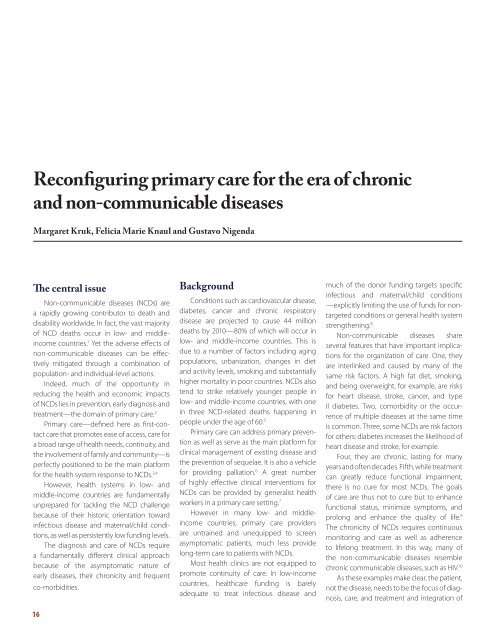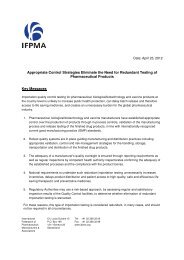Addressing the Gaps in Global Policy and Research for Non ... - IFPMA
Addressing the Gaps in Global Policy and Research for Non ... - IFPMA
Addressing the Gaps in Global Policy and Research for Non ... - IFPMA
You also want an ePaper? Increase the reach of your titles
YUMPU automatically turns print PDFs into web optimized ePapers that Google loves.
Reconfigur<strong>in</strong>g primary care <strong>for</strong> <strong>the</strong> era of chronic<br />
<strong>and</strong> non-communicable diseases<br />
Margaret Kruk, Felicia Marie Knaul <strong>and</strong> Gustavo Nigenda<br />
The central issue<br />
<strong>Non</strong>-communicable diseases (NCDs) are<br />
a rapidly grow<strong>in</strong>g contributor to death <strong>and</strong><br />
disability worldwide. In fact, <strong>the</strong> vast majority<br />
of NCD deaths occur <strong>in</strong> low- <strong>and</strong> middle<strong>in</strong>come<br />
countries. 1 Yet <strong>the</strong> adverse effects of<br />
non-communicable diseases can be effectively<br />
mitigated through a comb<strong>in</strong>ation of<br />
population- <strong>and</strong> <strong>in</strong>dividual-level actions.<br />
Indeed, much of <strong>the</strong> opportunity <strong>in</strong><br />
reduc<strong>in</strong>g <strong>the</strong> health <strong>and</strong> economic impacts<br />
of NCDs lies <strong>in</strong> prevention, early diagnosis <strong>and</strong><br />
treatment—<strong>the</strong> doma<strong>in</strong> of primary care. 2<br />
Primary care—def<strong>in</strong>ed here as first-contact<br />
care that promotes ease of access, care <strong>for</strong><br />
a broad range of health needs, cont<strong>in</strong>uity, <strong>and</strong><br />
<strong>the</strong> <strong>in</strong>volvement of family <strong>and</strong> community—is<br />
perfectly positioned to be <strong>the</strong> ma<strong>in</strong> plat<strong>for</strong>m<br />
<strong>for</strong> <strong>the</strong> health system response to NCDs. 3,4<br />
However, health systems <strong>in</strong> low- <strong>and</strong><br />
middle-<strong>in</strong>come countries are fundamentally<br />
unprepared <strong>for</strong> tackl<strong>in</strong>g <strong>the</strong> NCD challenge<br />
because of <strong>the</strong>ir historic orientation toward<br />
<strong>in</strong>fectious disease <strong>and</strong> maternal/child conditions,<br />
as well as persistently low fund<strong>in</strong>g levels.<br />
The diagnosis <strong>and</strong> care of NCDs require<br />
a fundamentally different cl<strong>in</strong>ical approach<br />
because of <strong>the</strong> asymptomatic nature of<br />
early diseases, <strong>the</strong>ir chronicity <strong>and</strong> frequent<br />
co-morbidities.<br />
16<br />
Background<br />
Conditions such as cardiovascular disease,<br />
diabetes, cancer <strong>and</strong> chronic respiratory<br />
disease are projected to cause 44 million<br />
deaths by 2010—80% of which will occur <strong>in</strong><br />
low- <strong>and</strong> middle-<strong>in</strong>come countries. This is<br />
due to a number of factors <strong>in</strong>clud<strong>in</strong>g ag<strong>in</strong>g<br />
populations, urbanization, changes <strong>in</strong> diet<br />
<strong>and</strong> activity levels, smok<strong>in</strong>g <strong>and</strong> substantially<br />
higher mortality <strong>in</strong> poor countries. NCDs also<br />
tend to strike relatively younger people <strong>in</strong><br />
low- <strong>and</strong> middle-<strong>in</strong>come countries, with one<br />
<strong>in</strong> three NCD-related deaths happen<strong>in</strong>g <strong>in</strong><br />
people under <strong>the</strong> age of 60. 5<br />
Primary care can address primary prevention<br />
as well as serve as <strong>the</strong> ma<strong>in</strong> plat<strong>for</strong>m <strong>for</strong><br />
cl<strong>in</strong>ical management of exist<strong>in</strong>g disease <strong>and</strong><br />
<strong>the</strong> prevention of sequelae. It is also a vehicle<br />
<strong>for</strong> provid<strong>in</strong>g palliation. 6 A great number<br />
of highly effective cl<strong>in</strong>ical <strong>in</strong>terventions <strong>for</strong><br />
NCDs can be provided by generalist health<br />
workers <strong>in</strong> a primary care sett<strong>in</strong>g. 7<br />
However <strong>in</strong> many low- <strong>and</strong> middle<strong>in</strong>come<br />
countries, primary care providers<br />
are untra<strong>in</strong>ed <strong>and</strong> unequipped to screen<br />
asymptomatic patients, much less provide<br />
long-term care to patients with NCDs.<br />
Most health cl<strong>in</strong>ics are not equipped to<br />
promote cont<strong>in</strong>uity of care. In low-<strong>in</strong>come<br />
countries, healthcare fund<strong>in</strong>g is barely<br />
adequate to treat <strong>in</strong>fectious disease <strong>and</strong><br />
much of <strong>the</strong> donor fund<strong>in</strong>g targets specific<br />
<strong>in</strong>fectious <strong>and</strong> maternal/child conditions<br />
—explicitly limit<strong>in</strong>g <strong>the</strong> use of funds <strong>for</strong> nontargeted<br />
conditions or general health system<br />
streng<strong>the</strong>n<strong>in</strong>g. 8<br />
<strong>Non</strong>-communicable diseases share<br />
several features that have important implications<br />
<strong>for</strong> <strong>the</strong> organization of care. One, <strong>the</strong>y<br />
are <strong>in</strong>terl<strong>in</strong>ked <strong>and</strong> caused by many of <strong>the</strong><br />
same risk factors. A high fat diet, smok<strong>in</strong>g,<br />
<strong>and</strong> be<strong>in</strong>g overweight, <strong>for</strong> example, are risks<br />
<strong>for</strong> heart disease, stroke, cancer, <strong>and</strong> type<br />
II diabetes. Two, comorbidity or <strong>the</strong> occurrence<br />
of multiple diseases at <strong>the</strong> same time<br />
is common. Three, some NCDs are risk factors<br />
<strong>for</strong> o<strong>the</strong>rs: diabetes <strong>in</strong>creases <strong>the</strong> likelihood of<br />
heart disease <strong>and</strong> stroke, <strong>for</strong> example.<br />
Four, <strong>the</strong>y are chronic, last<strong>in</strong>g <strong>for</strong> many<br />
years <strong>and</strong> often decades. Fifth, while treatment<br />
can greatly reduce functional impairment,<br />
<strong>the</strong>re is no cure <strong>for</strong> most NCDs. The goals<br />
of care are thus not to cure but to enhance<br />
functional status, m<strong>in</strong>imize symptoms, <strong>and</strong><br />
prolong <strong>and</strong> enhance <strong>the</strong> quality of life. 9<br />
The chronicity of NCDs requires cont<strong>in</strong>uous<br />
monitor<strong>in</strong>g <strong>and</strong> care as well as adherence<br />
to lifelong treatment. In this way, many of<br />
<strong>the</strong> non-communicable diseases resemble<br />
chronic communicable diseases, such as HIV. 10<br />
As <strong>the</strong>se examples make clear, <strong>the</strong> patient,<br />
not <strong>the</strong> disease, needs to be <strong>the</strong> focus of diagnosis,<br />
care, <strong>and</strong> treatment <strong>and</strong> <strong>in</strong>tegration of






